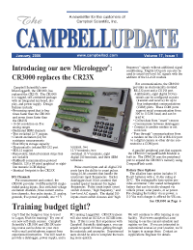A machine’s capability is only as useful as the operator’s understanding of the machine and its benefits. As the body of available technology expands for solving your measurement and data acquisition problems, one of our challenges is to make the benefits of new technology available to you without expanding complexity. Indeed, something can be said for new technology that simplifies a machine. In the design of dataloggers and associated machines at CSI, we strive to balance flexibility and simplicity. The right balance will give you an extraordinary value with data acquisition tools that require some investment of your time, but in return offer you expanding capabilities as your understanding increases.
While much of the internal operation of a datalogger is hidden from external view, an operator must at a minimum specify the measurements to be made, at what frequency, and the means of reporting a useful result. While there are a number of functions supported through a simple keyboard and display, most of the user interface of Campbell Scientific equipment is handled through PC software. We offer three basic levels of PC software:
- entry level that is downloadable from our web site (Short Cut and PC200W)
- mid-level for the individual user requiring programming and manual telemetry capability (PC400)
- top-level for supporting wide area networks with automated data retrieval through a variety of telemetry means (LoggerNet).
The release of LoggerNet 3.2 is a landmark event. LoggerNet 3.2 supports a broad variety of dataloggers and communication peripherals for wide area networking with a client/ server architecture that allows remote (Internet based) network administration as well as local or remote data export from the LoggerNet server. LoggerNet 3.2 also supports a new generation of dataloggers that includes the CR1000, CR3000, and several others that are programmed with an improved Short Cut program generator and with a full-featured CRBasic editor. Adherence to the BASIC syntax provides an easier entry into programming dataloggers. Improvements in the editor, CR1000, and related operating systems extends usefulness of the datalogger into applications requiring more on-site processing or handling strings in the data structure. LoggerNet 3.2 will also translate more readily into languages other than English.
For several years Campbell Scientific’s software development has been focused on improvements to the user interface, upgrades relating to Windows operating system as it moved to a 32-bit platform, and support for the new generation of dataloggers (CR1000, CR3000). While there is always an ongoing maintenance effort driven by market changes to computers and their operating systems, I foresee an opportunity to extend the range and functionality of software products in the future. Internal discussions have included the following topics:
- Improve datalogger network planning and set-up
- Wizard-based report generator to format printable reports
- Support for mainstream relational data bases
- Improve web publication support
- Integration with Geographic Information Systems (GIS)
- More sophisticated data analysis and graphics
- Enhanced troubleshooting and diagnostic tools
- LoggerNet server on LINUX (existing clients on Windows)
- Application specific adaptations.
As you read through the list, consider your use of Campbell Scientific software. Feel free to give us feedback on where you would like to see improvements or related products. Please direct this feedback to software@campbellsci.com.
We remain committed to an offering of software products that are easy to install and use on popular PC operating systems. If you haven’t tried our latest offerings, I invite you to visit www.campbellsci.com and review our software products.

